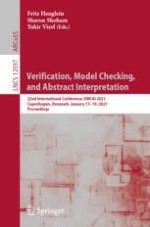This book constitutes the proceedings of the 22nd International Conference on Verification, Model Checking, and Abstract Interpretation, VMCAI 2021, which was held virtually during January 17-19, 2021. The conference was planned to take place in Copenhagen, Denmark, but changed to an online event due to the COVID-19 pandemic.
The 23 papers presented in this volume were carefully reviewed from 48 submissions. VMCAI provides a forum for researchers working on verification, model checking, and abstract interpretation and facilitates interaction, cross-fertilization, and advancement of hybrid methods that combine these and related areas. The papers presented in this volume were organized in the following topical sections: hyperproperties and infinite-state systems; concurrent and distributed systems; checking; synthesis and repair; applications; and decision procedures.
